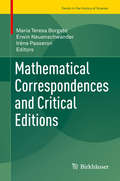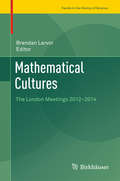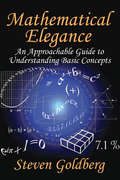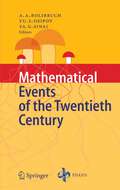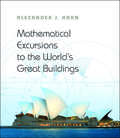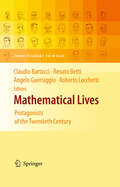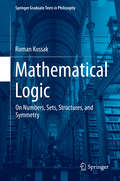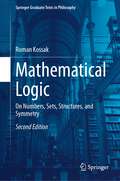- Table View
- List View
The Mathematical Career of Pierre de Fermat, 1601-1665: Second Edition
by Michael Sean MahoneyHailed as one of the greatest mathematical results of the twentieth century, the recent proof of Fermat's Last Theorem by Andrew Wiles brought to public attention the enigmatic problem-solver Pierre de Fermat, who centuries ago stated his famous conjecture in a margin of a book, writing that he did not have enough room to show his "truly marvelous demonstration." Along with formulating this proposition--xn+yn=zn has no rational solution for n > 2--Fermat, an inventor of analytic geometry, also laid the foundations of differential and integral calculus, established, together with Pascal, the conceptual guidelines of the theory of probability, and created modern number theory. In one of the first full-length investigations of Fermat's life and work, Michael Sean Mahoney provides rare insight into the mathematical genius of a hobbyist who never sought to publish his work, yet who ranked with his contemporaries Pascal and Descartes in shaping the course of modern mathematics.
The Mathematical Career of Pierre de Fermat, 1601-1665: Second Edition (PDF)
by Michael Sean MahoneyHailed as one of the greatest mathematical results of the twentieth century, the recent proof of Fermat's Last Theorem by Andrew Wiles brought to public attention the enigmatic problem-solver Pierre de Fermat, who centuries ago stated his famous conjecture in a margin of a book, writing that he did not have enough room to show his "truly marvelous demonstration." Along with formulating this proposition--xn+yn=zn has no rational solution for n > 2--Fermat, an inventor of analytic geometry, also laid the foundations of differential and integral calculus, established, together with Pascal, the conceptual guidelines of the theory of probability, and created modern number theory. In one of the first full-length investigations of Fermat's life and work, Michael Sean Mahoney provides rare insight into the mathematical genius of a hobbyist who never sought to publish his work, yet who ranked with his contemporaries Pascal and Descartes in shaping the course of modern mathematics.
The Mathematical Century: The 30 Greatest Problems of the Last 100 Years
by Piergiorgio Odifreddi Arturo Sangalli Freeman DysonThe twentieth century was a time of unprecedented development in mathematics, as well as in all sciences: more theorems were proved and results found in a hundred years than in all of previous history. In The Mathematical Century, Piergiorgio Odifreddi distills this unwieldy mass of knowledge into a fascinating and authoritative overview of the subject. He concentrates on thirty highlights of pure and applied mathematics. Each tells the story of an exciting problem, from its historical origins to its modern solution, in lively prose free of technical details. Odifreddi opens by discussing the four main philosophical foundations of mathematics of the nineteenth century and ends by describing the four most important open mathematical problems of the twenty-first century. In presenting the thirty problems at the heart of the book he devotes equal attention to pure and applied mathematics, with applications ranging from physics and computer science to biology and economics. Special attention is dedicated to the famous "23 problems" outlined by David Hilbert in his address to the International Congress of Mathematicians in 1900 as a research program for the new century, and to the work of the winners of the Fields Medal, the equivalent of a Nobel prize in mathematics. This eminently readable book will be treasured not only by students and their teachers but also by all those who seek to make sense of the elusive macrocosm of twentieth-century mathematics.
The Mathematical Coloring Book: Mathematics of Coloring and the Colorful Life of its Creators
by Alexander SoiferThis book provides an exciting history of the discovery of Ramsey Theory, and contains new research along with rare photographs of the mathematicians who developed this theory, including Paul Erdös, B.L. van der Waerden, and Henry Baudet.
Mathematical Communities in the Reconstruction After the Great War 1918–1928: Trajectories and Institutions (Trends in the History of Science)
by Laurent Mazliak Rossana TazzioliThis book is a consequence of the international meeting organized in Marseilles in November 2018 devoted to the aftermath of the Great War for mathematical communities. It features selected original research presented at the meeting offering a new perspective on a period, the 1920s, not extensively considered by historiography.After 1918, new countries were created, and borders of several others were modified. Territories were annexed while some countries lost entire regions. These territorial changes bear witness to the massive and varied upheavals with which European societies were confronted in the aftermath of the Great War. The reconfiguration of political Europe was accompanied by new alliances and a redistribution of trade – commercial, intellectual, artistic, military, and so on – which largely shaped international life during the interwar period. These changes also had an enormous impact on scientific life, not only in practice, but also in its organization and communication strategies.The mathematical sciences, which from the late 19th century to the 1920s experienced a deep disciplinary evolution, were thus facing a double movement, internal and external, which led to a sustainable restructuring of research and teaching. Concomitantly, various areas such as topology, functional analysis, abstract algebra, logic or probability, among others, experienced exceptional development. This was accompanied by an explosion of new international or national associations of mathematicians with for instance the founding, in 1918, of the International Mathematical Union and the controversial creation of the International Research Council. Therefore, the central idea for the articulation of the various chapters of the book is to present case studies illustrating how in the aftermath of the war, many mathematicians had to organize their personal trajectories taking into account the evolution of the political, social and scientific environment which had taken place at the end of the conflict.
Mathematical Correspondences and Critical Editions (Trends in the History of Science)
by Maria Teresa Borgato Erwin Neuenschwander Irène PasseronMathematical correspondence offers a rich heritage for the history of mathematics and science, as well as cultural history and other areas. It naturally covers a vast range of topics, and not only of a scientific nature; it includes letters between mathematicians, but also between mathematicians and politicians, publishers, and men or women of culture. Wallis, Leibniz, the Bernoullis, D'Alembert, Condorcet, Lagrange, Gauss, Hermite, Betti, Cremona, Poincaré and van der Waerden are undoubtedly authors of great interest and their letters are valuable documents, but the correspondence of less well-known authors, too, can often make an equally important contribution to our understanding of developments in the history of science. Mathematical correspondences also play an important role in the editions of collected works, contributing to the reconstruction of scientific biographies, as well as the genesis of scientific ideas, and in the correct dating and interpretation of scientific writings. This volume is based on the symposium “Mathematical Correspondences and Critical Editions,” held at the 6th International Conference of the ESHS in Lisbon, Portugal in 2014. In the context of the more than fifteen major and minor editions of mathematical correspondences and collected works presented in detail, the volume discusses issues such as • History and prospects of past and ongoing edition projects, • Critical aspects of past editions, • The complementary role of printed and digital editions, • Integral and partial editions of correspondence, • Reproduction techniques for manuscripts, images and formulae, and the editorial challenges and opportunities presented by digital technology.
Mathematical Cultures: The London Meetings 2012-2014 (Trends in the History of Science)
by Brendan LarvorThis collection presents significant contributions from an international network project on mathematical cultures, including essays from leading scholars in the history and philosophy of mathematics and mathematics education. Mathematics has universal standards of validity. Nevertheless, there are local styles in mathematical research and teaching, and great variation in the place of mathematics in the larger cultures that mathematical practitioners belong to. The reflections on mathematical cultures collected in this book are of interest to mathematicians, philosophers, historians, sociologists, cognitive scientists and mathematics educators.
Mathematical Demography: Selected Papers (Demographic Research Monographs)
by David P. Smith Nathan KeyfitzMathematical demography is the centerpiece of quantitative social science. The founding works of this field from Roman times to the late Twentieth Century are collected here, in a new edition of a classic work by David R. Smith and Nathan Keyfitz. Commentaries by Smith and Keyfitz have been brought up to date and extended by Kenneth Wachter and Hervé Le Bras, giving a synoptic picture of the leading achievements in formal population studies. Like the original collection, this new edition constitutes an indispensable source for students and scientists alike, and illustrates the deep roots and continuing vitality of mathematical demography.
Mathematical Elegance: An Approachable Guide to Understanding Basic Concepts
by Steven GoldbergThe heart of mathematics is its elegance; the way it all fits together. Unfortunately, its beauty often eludes the vast majority of people who are intimidated by fear of the difficulty of numbers. Mathematical Elegance remedies this. Using hundreds of examples, the author presents a view of the mathematical landscape that is both accessible and fascinating. At a time of concern that American youth are bored by math, there is renewed interest in improving math skills. Mathematical Elegance stimulates students, along with those already experienced in the discipline, to explore some of the unexpected pleasures of quantitative thinking. Invoking mathematical proofs famous for their simplicity and brainteasers that are fun and illuminating, the author leaves readers feeling exuberant-as well as convinced that their IQs have been raised by ten points. A host of anecdotes about well-known mathematicians humanize and provide new insights into their lofty subjects. Recalling such classic works as Lewis Carroll's Introduction to Logic and A Mathematician Reads the Newspaper by John Allen Paulos, Mathematical Elegance will energize and delight a wide audience, ranging from intellectually curious students to the enthusiastic general reader.
Mathematical Elegance: An Approachable Guide to Understanding Basic Concepts
by Steven GoldbergThe heart of mathematics is its elegance; the way it all fits together. Unfortunately, its beauty often eludes the vast majority of people who are intimidated by fear of the difficulty of numbers. Mathematical Elegance remedies this. Using hundreds of examples, the author presents a view of the mathematical landscape that is both accessible and fascinating. At a time of concern that American youth are bored by math, there is renewed interest in improving math skills. Mathematical Elegance stimulates students, along with those already experienced in the discipline, to explore some of the unexpected pleasures of quantitative thinking. Invoking mathematical proofs famous for their simplicity and brainteasers that are fun and illuminating, the author leaves readers feeling exuberant-as well as convinced that their IQs have been raised by ten points. A host of anecdotes about well-known mathematicians humanize and provide new insights into their lofty subjects. Recalling such classic works as Lewis Carroll's Introduction to Logic and A Mathematician Reads the Newspaper by John Allen Paulos, Mathematical Elegance will energize and delight a wide audience, ranging from intellectually curious students to the enthusiastic general reader.
Mathematical Encounters of the Second Kind
by Philip J. DavisA number of years ago, Harriet Sheridan, then Dean of Brown University, organized a series oflectures in which individual faculty members described how it came about that they entered their various fields. I was invited to participate in this series and found in the invitation an opportunity to recall events going back to my early teens. The lecture was well received and its reception encouraged me to work up an expanded version. My manuscript lay dormant all these years. In the meanwhile, sufficiently many other mathematical experiences and encounters accumulated to make this little book. My 1981 lecture is the basis of the first piece: "Napoleon's Theorem. " Although there is a connection between the first piece and the second, the four pieces here are essentially independent. The sec ond piece, "Carpenter and the Napoleon Ascription," has as its object a full description of a certain type of scholar-storyteller (of whom I have known and admired several). It is a pastiche, contain ing a salad bar selection blended together by my own imagination. This piece purports, as a secondary goal, to present a solution to a certain unsolved historical problem raised in the first piece. The third piece, "The Man Who Began His Lectures with 'Namely'," is a short reminiscence of Stefan Bergman, one of my teachers of graduate mathematics. Bergman, a remarkable person ality, was born in Poland and came to the United States in 1939.
Mathematical Epistemology and Psychology (Synthese Library #12)
by E.W. Beth J. PiagetOne of the controversial philosophical issues of recent years has been the question of the nature of logical and mathematical entities. Platonist or linguistic modes of explanation have become fashionable, whilst abstrac tionist and constructionist theories have ceased to be so. Beth and Piaget approach this problem in their book from two somewhat different points of view. Beth's approach is largely historico-critical, although he discusses the nature of heuristic thinking in mathematics, whilst that of Piaget is psycho-genetic. The major purpose of this introduction is to summarise some of the main points of their respective arguments. In the first part of this book Beth makes a detailed study of the history of philosophical thinking about mathematics, and draws our attention to the important role played by the Aristotelian methodology of the demon strative sciences. This, he tells us, is characterised by three postulates: (a) deductivity, (b) self-evidence, and (c) reality. The last postulate asserts that the primitive notions of a demonstrative science must have reference to a domain of real entities in order to have significance. On the Aristote lian view discursive reasoning plays a major role in mathematics, whilst pure intuition plays a somewhat subordinate one.
Mathematical Events of the Twentieth Century
by Vladimir I. Arnold Ludwig Faddeev Yu. I. Manin V. B. Filippov Vladimir M. Tikhomirov Anatoly M. VershikThis book contains several contributions on the most outstanding events in the development of twentieth century mathematics, representing a wide variety of specialities in which Russian and Soviet mathematicians played a considerable role. The articles are written in an informal style, from mathematical philosophy to the description of the development of ideas, personal memories and give a unique account of personal meetings with famous representatives of twentieth century mathematics who exerted great influence in its development. This book will be of great interest to mathematicians, who will enjoy seeing their own specialities described with some historical perspective. Historians will read it with the same motive, and perhaps also to select topics for future investigation.
Mathematical Excursions to the World's Great Buildings
by Alexander J. HahnFrom the pyramids and the Parthenon to the Sydney Opera House and the Bilbao Guggenheim, this book takes readers on an eye-opening tour of the mathematics behind some of the world's most spectacular buildings. Beautifully illustrated, the book explores the milestones in elementary mathematics that enliven the understanding of these buildings and combines this with an in-depth look at their aesthetics, history, and structure. Whether using trigonometry and vectors to explain why Gothic arches are structurally superior to Roman arches, or showing how simple ruler and compass constructions can produce sophisticated architectural details, Alexander Hahn describes the points at which elementary mathematics and architecture intersect. Beginning in prehistoric times, Hahn proceeds to guide readers through the Greek, Roman, Islamic, Romanesque, Gothic, Renaissance, and modern styles. He explores the unique features of the Pantheon, the Hagia Sophia, the Great Mosque of Cordoba, the Duomo in Florence, Palladio's villas, and Saint Peter's Basilica, as well as the U.S. Capitol Building. Hahn celebrates the forms and structures of architecture made possible by mathematical achievements from Greek geometry, the Hindu-Arabic number system, two- and three-dimensional coordinate geometry, and calculus. Along the way, Hahn introduces groundbreaking architects, including Brunelleschi, Alberti, da Vinci, Bramante, Michelangelo, della Porta, Wren, Gaudí, Saarinen, Utzon, and Gehry. Rich in detail, this book takes readers on an expedition around the globe, providing a deeper understanding of the mathematical forces at play in the world's most elegant buildings.
The Mathematical Experience, Study Edition (Modern Birkhäuser Classics)
by Philip Davis Reuben Hersh Elena Anne MarchisottoWinner of the 1983 National Book Award!"…a perfectly marvelous book about the Queen of Sciences, from which one will get a real feeling for what mathematicians do and who they are. The exposition is clear and full of wit and humor..." - The New Yorker (1983 National Book Award edition)Mathematics has been a human activity for thousands of years. Yet only a few people from the vast population of users are professional mathematicians, who create, teach, foster, and apply it in a variety of situations. The authors of this book believe that it should be possible for these professional mathematicians to explain to non-professionals what they do, what they say they are doing, and why the world should support them at it. They also believe that mathematics should be taught to non-mathematics majors in such a way as to instill an appreciation of the power and beauty of mathematics. Many people from around the world have told the authors that they have done precisely that with the first edition and they have encouraged publication of this revised edition complete with exercises for helping students to demonstrate their understanding. This edition of the book should find a new generation of general readers and students who would like to know what mathematics is all about. It will prove invaluable as a course text for a general mathematics appreciation course, one in which the student can combine an appreciation for the esthetics with some satisfying and revealing applications.The text is ideal for 1) a GE course for Liberal Arts students 2) a Capstone course for perspective teachers 3) a writing course for mathematics teachers. A wealth of customizable online course materials for the book can be obtained from Elena Anne Marchisotto (elena.marchisotto@csun.edu) upon request.
Mathematical Geography in the Eighteenth Century: Euler, Lagrange and Lambert
by Renzo Caddeo Athanase PapadopoulosThis volume presents the beautiful memoirs of Euler, Lagrange and Lambert on geography, translated into English and put into perspective through explanatory and historical essays as well as commentaries and mathematical notes. These works had a major impact on the development of the differential geometry of surfaces and they deserve to be studied, not only as historical documents, but most of all as a rich source of ideas.
Mathematical Intuitionism and Intersubjectivity: A Critical Exposition of Arguments for Intuitionism (Synthese Library #279)
by Tomasz PlacekIn 1907 Luitzen Egbertus Jan Brouwer defended his doctoral dissertation on the foundations of mathematics and with this event the modem version of mathematical intuitionism came into being. Brouwer attacked the main currents of the philosophy of mathematics: the formalists and the Platonists. In tum, both these schools began viewing intuitionism as the most harmful party among all known philosophies of mathematics. That was the origin of the now-90-year-old debate over intuitionism. As both sides have appealed in their arguments to philosophical propositions, the discussions have attracted the attention of philosophers as well. One might ask here what role a philosopher can play in controversies over mathematical intuitionism. Can he reasonably enter into disputes among mathematicians? I believe that these disputes call for intervention by a philo sopher. The three best-known arguments for intuitionism, those of Brouwer, Heyting and Dummett, are based on ontological and epistemological claims, or appeal to theses that properly belong to a theory of meaning. Those lines of argument should be investigated in order to find what their assumptions are, whether intuitionistic consequences really follow from those assumptions, and finally, whether the premises are sound and not absurd. The intention of this book is thus to consider seriously the arguments of mathematicians, even if philosophy was not their main field of interest. There is little sense in disputing whether what mathematicians said about the objectivity and reality of mathematical facts belongs to philosophy, or not.
Mathematical Knowledge and the Interplay of Practices
by José FerreirósThis book presents a new approach to the epistemology of mathematics by viewing mathematics as a human activity whose knowledge is intimately linked with practice. Charting an exciting new direction in the philosophy of mathematics, José Ferreirós uses the crucial idea of a continuum to provide an account of the development of mathematical knowledge that reflects the actual experience of doing math and makes sense of the perceived objectivity of mathematical results.Describing a historically oriented, agent-based philosophy of mathematics, Ferreirós shows how the mathematical tradition evolved from Euclidean geometry to the real numbers and set-theoretic structures. He argues for the need to take into account a whole web of mathematical and other practices that are learned and linked by agents, and whose interplay acts as a constraint. Ferreirós demonstrates how advanced mathematics, far from being a priori, is based on hypotheses, in contrast to elementary math, which has strong cognitive and practical roots and therefore enjoys certainty.Offering a wealth of philosophical and historical insights, Mathematical Knowledge and the Interplay of Practices challenges us to rethink some of our most basic assumptions about mathematics, its objectivity, and its relationship to culture and science.
Mathematical Knowledge and the Interplay of Practices
by José FerreirósThis book presents a new approach to the epistemology of mathematics by viewing mathematics as a human activity whose knowledge is intimately linked with practice. Charting an exciting new direction in the philosophy of mathematics, José Ferreirós uses the crucial idea of a continuum to provide an account of the development of mathematical knowledge that reflects the actual experience of doing math and makes sense of the perceived objectivity of mathematical results.Describing a historically oriented, agent-based philosophy of mathematics, Ferreirós shows how the mathematical tradition evolved from Euclidean geometry to the real numbers and set-theoretic structures. He argues for the need to take into account a whole web of mathematical and other practices that are learned and linked by agents, and whose interplay acts as a constraint. Ferreirós demonstrates how advanced mathematics, far from being a priori, is based on hypotheses, in contrast to elementary math, which has strong cognitive and practical roots and therefore enjoys certainty.Offering a wealth of philosophical and historical insights, Mathematical Knowledge and the Interplay of Practices challenges us to rethink some of our most basic assumptions about mathematics, its objectivity, and its relationship to culture and science.
Mathematical Knowledge, Objects and Applications: Essays in Memory of Mark Steiner (Jerusalem Studies in Philosophy and History of Science)
by Carl J. Posy Yemima Ben-MenahemThis book provides a survey of a number of the major issues in the philosophy of mathematics, such as ontological questions regarding the nature of mathematical objects, epistemic questions about the acquisition of mathematical knowledge, and the intriguing riddle of the applicability of mathematics to the physical world. Some of these issues go back to the nascent years of mathematics itself, others are just beginning to draw the attention of scholars. In addressing these questions, some of the papers in this volume wrestle with them directly, while others use the writings of philosophers such as Hume and Wittgenstein to approach their problems by way of interpretation and critique. The contributors include prominent philosophers of science and mathematics as well as promising younger scholars. The volume seeks to share the concerns of philosophers of mathematics with a wider audience and will be of interest to historians, mathematicians and philosophers alike.
The Mathematical Legacy of Eduard Čech
by KATETOV SIMONThe work of Professor Eduard Cech had a si~ificant influence on the development of algebraic and general topology and differential geometry. This book, which appears on the occasion of the centenary of Cech's birth, contains some of his most important papers and traces the subsequent trends emerging from his ideas. The body of the book consists of four chapters devoted to algebraic topology, Cech-Stone compactification, dimension theory and differential geometry. Each of these includes a selection of Cech's papers, a brief summary of some results which followed from his work or constituted solutions to the problems he posed, and several selected papers by various authors concerning the areas of study he initiated. The book also contains a concise biography borrowed with minor changes from the book Topological papers of E. tech, a list of Cech's publications and a very brief note on his activity in the didactics of mathematics. The editors wish to express their sincere gratitude to all who contributed to the completion and publication of this book.
The Mathematical Legacy of Srinivasa Ramanujan
by M. Ram Murty V. Kumar MurtySrinivasa Ramanujan was a mathematician brilliant beyond comparison who inspired many great mathematicians. There is extensive literature available on the work of Ramanujan. But what is missing in the literature is an analysis that would place his mathematics in context and interpret it in terms of modern developments. The 12 lectures by Hardy, delivered in 1936, served this purpose at the time they were given. This book presents Ramanujan’s essential mathematical contributions and gives an informal account of some of the major developments that emanated from his work in the 20th and 21st centuries. It contends that his work still has an impact on many different fields of mathematical research. This book examines some of these themes in the landscape of 21st-century mathematics. These essays, based on the lectures given by the authors focus on a subset of Ramanujan’s significant papers and show how these papers shaped the course of modern mathematics.
Mathematical Lives: Protagonists of the Twentieth Century From Hilbert to Wiles
by Roberto Lucchetti Kim Williams Claudio Bartocci Renato Betti Angelo GuerraggioSteps forward in mathematics often reverberate in other scientific disciplines, and give rise to innovative conceptual developments or find surprising technological applications. This volume brings to the forefront some of the proponents of the mathematics of the twentieth century, who have put at our disposal new and powerful instruments for investigating the reality around us. The portraits present people who have impressive charisma and wide-ranging cultural interests, who are passionate about defending the importance of their own research, are sensitive to beauty, and attentive to the social and political problems of their times. What we have sought to document is mathematics’ central position in the culture of our day. Space has been made not only for the great mathematicians but also for literary texts, including contributions by two apparent interlopers, Robert Musil and Raymond Queneau, for whom mathematical concepts represented a valuable tool for resolving the struggle between ‘soul and precision.’
Mathematical Logic: On Numbers, Sets, Structures, and Symmetry (Springer Graduate Texts in Philosophy #3)
by Roman KossakThis book, presented in two parts, offers a slow introduction to mathematical logic, and several basic concepts of model theory, such as first-order definability, types, symmetries, and elementary extensions. Its first part, Logic Sets, and Numbers, shows how mathematical logic is used to develop the number structures of classical mathematics. The exposition does not assume any prerequisites; it is rigorous, but as informal as possible. All necessary concepts are introduced exactly as they would be in a course in mathematical logic; but are accompanied by more extensive introductory remarks and examples to motivate formal developments. The second part, Relations, Structures, Geometry, introduces several basic concepts of model theory, such as first-order definability, types, symmetries, and elementary extensions, and shows how they are used to study and classify mathematical structures. Although more advanced, this second part is accessible to the reader who is either already familiar with basic mathematical logic, or has carefully read the first part of the book. Classical developments in model theory, including the Compactness Theorem and its uses, are discussed. Other topics include tameness, minimality, and order minimality of structures. The book can be used as an introduction to model theory, but unlike standard texts, it does not require familiarity with abstract algebra. This book will also be of interest to mathematicians who know the technical aspects of the subject, but are not familiar with its history and philosophical background.
Mathematical Logic: On Numbers, Sets, Structures, and Symmetry (Springer Graduate Texts in Philosophy #4)
by Roman KossakThis textbook is a second edition of the successful, Mathematical Logic: On Numbers, Sets, Structures, and Symmetry. It retains the original two parts found in the first edition, while presenting new material in the form of an added third part to the textbook. The textbook offers a slow introduction to mathematical logic, and several basic concepts of model theory, such as first-order definability, types, symmetries, and elementary extensions. Part I, Logic Sets, and Numbers, shows how mathematical logic is used to develop the number structures of classical mathematics. All necessary concepts are introduced exactly as they would be in a course in mathematical logic; but are accompanied by more extensive introductory remarks and examples to motivate formal developments. The second part, Relations, Structures, Geometry, introduces several basic concepts of model theory, such as first-order definability, types, symmetries, and elementary extensions, and shows how they are usedto study and classify mathematical structures. The added Part III to the book is closer to what one finds in standard introductory mathematical textbooks. Definitions, theorems, and proofs that are introduced are still preceded by remarks that motivate the material, but the exposition is more formal, and includes more advanced topics. The focus is on the notion of countable categoricity, which analyzed in detail using examples from the first two parts of the book. This textbook is suitable for graduate students in mathematical logic and set theory and will also be of interest to mathematicians who know the technical aspects of the subject, but are not familiar with its history and philosophical background.





